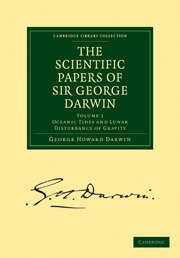Book contents
- Frontmatter
- PREFACE
- Contents
- Chronological List of Papers with References to the Volumes in which they probably will be contained
- PART I OCEANIC TIDES
- ART. 1 The Harmonic Analysis of Tidal Observations
- ART. 2 On the Periods Chosen for Harmonic Analysis, and a Comparison with the Older Methods by means of Hour-angles and Declinations
- ART. 3 Datum Levels: the Treatment of a Short Series of Tidal Observations and on Tidal Prediction
- ART. 4 A General Article on the Tides
- ART. 5 On the Harmonic Analysis of Tidal Observations of High and Low Water
- ART. 6 On an Apparatus for Facilitating the Reduction of Tidal Observations
- ART. 7 On Tidal Prediction
- ART. 8 On the Correction to the Equilibrium Theory of Tides for the Continents
- ART. 9 Attempted Evaluation of the Rigidity of the Earth from the Tides of Long Period
- ART. 10 Dynamical Theory of the Tides
- ART. 11 On the Dynamical Theory of the Tides of Long Period
- ART. 12 On the Antarctic Tidal Observations of the ‘Discovery’
- PART II THE LUNAR DISTURBANCE OF GRAVITY
- INDEX
- Plate section
ART. 7 - On Tidal Prediction
Published online by Cambridge University Press: 07 September 2010
- Frontmatter
- PREFACE
- Contents
- Chronological List of Papers with References to the Volumes in which they probably will be contained
- PART I OCEANIC TIDES
- ART. 1 The Harmonic Analysis of Tidal Observations
- ART. 2 On the Periods Chosen for Harmonic Analysis, and a Comparison with the Older Methods by means of Hour-angles and Declinations
- ART. 3 Datum Levels: the Treatment of a Short Series of Tidal Observations and on Tidal Prediction
- ART. 4 A General Article on the Tides
- ART. 5 On the Harmonic Analysis of Tidal Observations of High and Low Water
- ART. 6 On an Apparatus for Facilitating the Reduction of Tidal Observations
- ART. 7 On Tidal Prediction
- ART. 8 On the Correction to the Equilibrium Theory of Tides for the Continents
- ART. 9 Attempted Evaluation of the Rigidity of the Earth from the Tides of Long Period
- ART. 10 Dynamical Theory of the Tides
- ART. 11 On the Dynamical Theory of the Tides of Long Period
- ART. 12 On the Antarctic Tidal Observations of the ‘Discovery’
- PART II THE LUNAR DISTURBANCE OF GRAVITY
- INDEX
- Plate section
Summary
INTRODUCTION.
At most places on the North Atlantic the prediction of high and low water is fairly easy, because there is hardly any diurnal tide. This abnormality makes it sufficient to have a table of the mean fortnightly inequality in the height and interval after lunar transit, supplemented by tables of corrections for the declinations and parallaxes of the disturbing bodies. But when there is a large diurnal inequality, as is commonly the case in other seas, the heights and intervals after the upper and lower lunar transits are widely different; the two halves of each lunation differ much in their characters, and the season of the year has great influence. Thus simple tables, such as are applicable in the absence of diurnal tide, are of no avail.
The tidal information supplied by the Admiralty for such places, consists of rough means of the rise and interval at spring and neap, modified by the important warning that the tide is affected by diurnal inequality. Information of this kind affords scarcely any indication of the time and height of high and low water on any given day, and must, I should think, be almost useless.
This is the present state of affairs at many ports of some importance, but at others a specially constructed tide-table for each day of each year is published in advance. A special tide-table is clearly the best sort of information for the sailor, but the heavy expense of prediction and publication is rarely incurred, except at ports of first rate commercial importance.
- Type
- Chapter
- Information
- The Scientific Papers of Sir George DarwinOceanic Tides and Lunar Disturbance of Gravity, pp. 258 - 327Publisher: Cambridge University PressPrint publication year: 2009First published in: 1907



